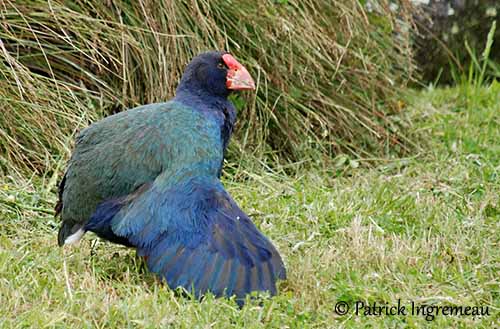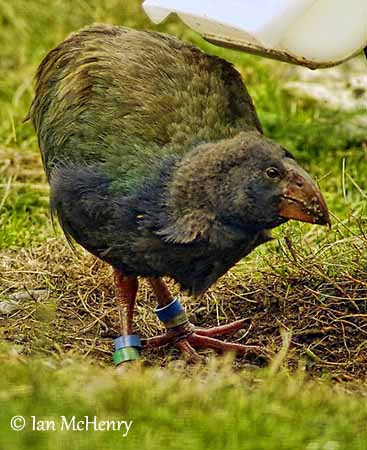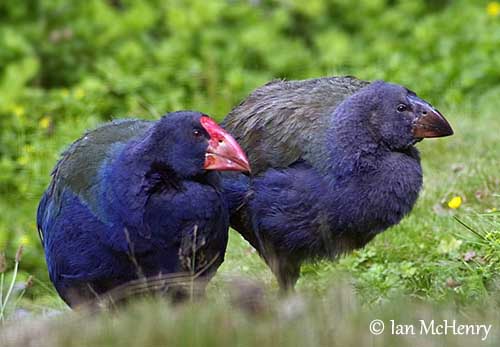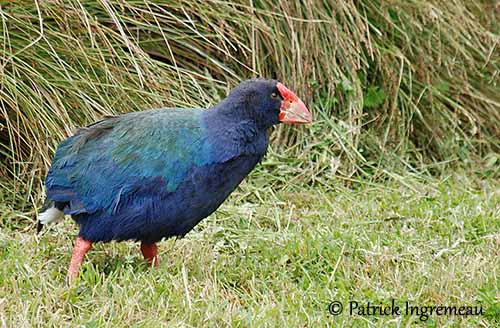
Fr: Talève takahé
All: Südinsel Takahe
Sd: Takahe
Photographer:
Patrick Ingremeau
TAMANDUA
Ian McHenry
My New Zealand Birds
Text by Nicole Bouglouan
Sources:
HANDBOOK OF THE BIRDS OF THE WORLD Vol 3 by Josep del Hoyo-Andrew Elliott-Jordi Sargatal - Lynx Edicions - ISBN : 8487334202
KNOW YOUR NEW ZEALAND BIRDS by Lynnette Moon - New Holland Publishers – ISBN: 1869660897
L’ENCYCLOPEDIE MONDIALE DES OISEAUX - Dr Christopher M. Perrins - BORDAS - ISBN: 2040185607
BirdLife International (BirdLife International)
New Zealand birds and birding (Narena Olliver)
Te Ara – The Encyclopedia of New Zealand
Tiritiri Matangi Open Sanctuary
Wikipedia, the free encyclopaedia
Takahe
Porphyrio hochstetteri
Gruiformes Order – Rallidae Family
INTRODUCTION:
The Mohoau or North Island Takahe (Porphyrio mantelli) was formerly living in New Zealand. But as a flightless species, this large bird suffered large declines due to introduced predators, and was hunted for food by Maoris. Described first in 1849, it was thought to be extinct in 1898-1900s.
However, some tens of birds were rediscovered in 1948 by Dr Geoffroy Orbell in the Murchison Mountains of Fiordland, South Island. The scientific name of the Takahe which is an extant species of P. mantelli, pays tribute to the German geologist Ferdinand von Hochstetter.
The Takahe is a survivor, still alive in spite of hunting pressure, destruction of the habitat and introduced predators. But even after years of conservation effort, this species remains Endangered with less than 250 adult birds.
DESCRIPTION OF THE BIRD:
Biometrics:
Length: 63 cm
Tall: 50 cm
Weight: M: 2700 g – F: 2300 g
This large Rallidae has reduced wings and does not fly.
The stocky body shows beautiful green and blue glossy plumage, with subtle turquoise sheen, ranging from iridescent dark blue head, neck, breast and shoulders, to olive-green and blue wings, tail and back. Vent and undertail-coverts are white.
The massive bill and the frontal shield are red, with brighter bill base and frontal shield. The eyes are reddish-brown. Powerful legs and feet are red.

The female has similar plumage but she is slightly smaller than the male.
The juvenile has brownish-grey head, neck and upperparts. Face and throat are mottled white. Breast and upper flanks are dull purplish-blue whereas rear flanks and vent are creamy-buff, with white undertail-coverts. The eyes are dark brown to grey. The bill is blackish. Legs and feet are brownish.
The immature resembles adult but it is slightly duller, with pinkish, washed blue bill. Legs and feet are dull red. By 5-6 months, the eyes get the adult colour.
RANGE:
The Takahe is endemic to New Zealand. It is present in the Murchison Mountains in Fiordland, and it has been introduced to the offshore islands of Tiritiri Matangi, Kapiti, Mana, Maud and Rarotoka.
The Mohoau (P. mantelli) originally occurred throughout the North Island and it is now extinct. The latest sights of this bird were in Tararua Range. This species was taller and slender then the Takahe.
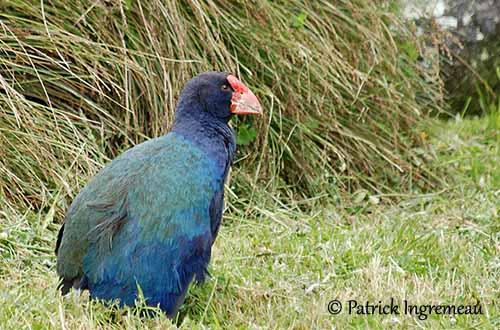
HABITAT:
The Takahe frequents the grasslands where it can find shrubs for shelter. In Fiordland, it can be seen in alpine tussock grasslands.
During the snowy winter, it moves to the adjacent beech forest. But even spending some time in forest, this species prefers the grassland areas with scattered shrubs.
CALLS AND SONGS: SOUNDS BY XENO-CANTO
The Takahe’s main calls are a loud shriek, a quiet hooting call used as contact call “coo-eet”, and a deep boom “oomf” as alarm call.
During the breeding season, the pairs sing in duets with alternating sounds.
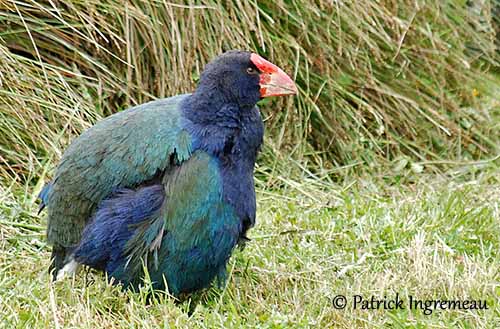
BEHAVIOUR IN THE WILD:
The Takahe is vegetarian, and usually feeds on a variety of plant matter including roots, shoots, leaf bases of red tussock (Chionochloa), sedges (Uncinia), rushes (Juncus) and Aciphylla plant species.
It also strips the grass seeds from the stems and takes fallen berries.
During the winter in forest habitat, it digs for underground fern rhizomes and other roots.
It may sometimes take large insects such as moths, beetles and weta (orthoptera) as proteins.
When the Takahe feeds on foliage, it takes shoots and stems and while holding them in one foot, it chews on the plant for the juices, in parrot-like feeding behaviour. Unfortunately, the introduced Red Deer involves competition for this type of food.
The Takahe is active throughout the day.
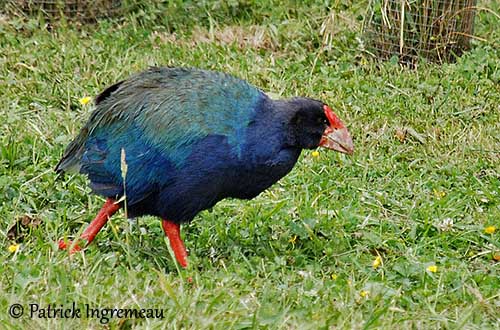
The pair is monogamous and has permanent pair-bonds. They live in pairs or small family groups. The Takahe is territorial and both mates defend the territory by calling loudly and sometimes, fights may occur.
The Takahe uses its short wings during displays and aggressive behaviour. The white undertail-coverts are exposed too by raising the short tail. Both mates call to each other in duet, uttering a very deep, resonant “kloomph”.
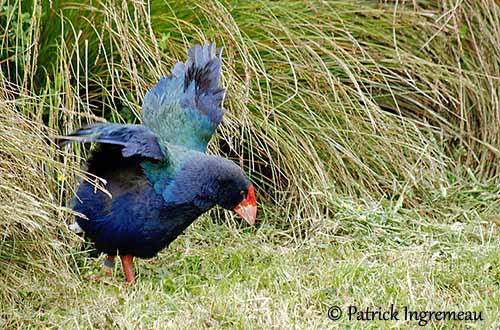
They breed in loose colonies and each pair holds the same territory year after year. They may sometimes breed in family groups, and the first year birds may act as helpers, incubating and caring the young.
The Takahe cannot fly and is sedentary. It only moves in winter, when the grasslands are covered in snow. They are able to move over great distances by walking or running.
REPRODUCTION OF THIS SPECIES:
In Fiordland, the laying occurs between late October and January. But it starts in September in the lower sites.
The nest is on the ground in well drained area. It is built in tussock grass. This is a bowl-shaped pile of grass and leaves, usually with two entrances and runways. It is built by both adults.
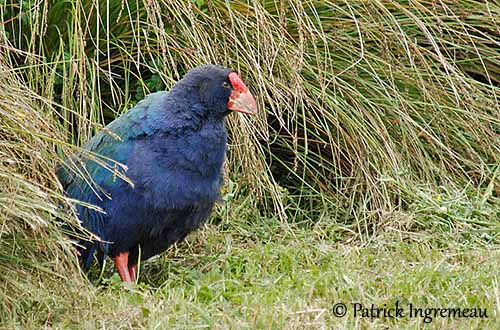
PROTECTION / THREATS / STATUS:
The Takahe has an extremely small population of about 227 adult birds. The numbers are increasing slowly, thanks to control of introduced predators, captive-rearing, intense management of these populations by supplementary feeding, inter-island transfers and removal of infertile eggs to promote re-nesting.
This species is currently listed as Endangered.
